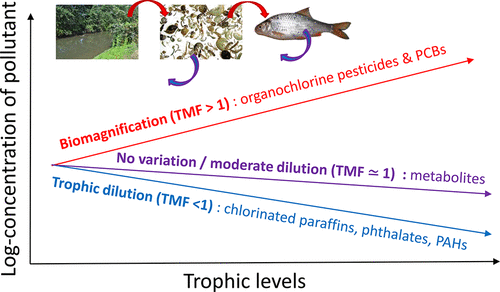当前位置:
X-MOL 学术
›
Environ. Sci. Technol.
›
论文详情
Our official English website, www.x-mol.net, welcomes your
feedback! (Note: you will need to create a separate account there.)
Trophic Transfer of Micropollutants and Their Metabolites in an Urban Riverine Food Web.
Environmental Science & Technology ( IF 10.8 ) Pub Date : 2020-06-04 , DOI: 10.1021/acs.est.0c01411 Aurélie Goutte 1 , Fabrice Alliot 1 , Hélène Budzinski 2 , Caroline Simonnet-Laprade 2 , Raphaël Santos 3 , Victor Lachaux 1 , Kevin Maciejewski 2 , Karyn Le Menach 2 , Pierre Labadie 2
Environmental Science & Technology ( IF 10.8 ) Pub Date : 2020-06-04 , DOI: 10.1021/acs.est.0c01411 Aurélie Goutte 1 , Fabrice Alliot 1 , Hélène Budzinski 2 , Caroline Simonnet-Laprade 2 , Raphaël Santos 3 , Victor Lachaux 1 , Kevin Maciejewski 2 , Karyn Le Menach 2 , Pierre Labadie 2
Affiliation

|
Trophic magnification factors (TMFs, i.e., the average change in the log-concentration of a pollutant per trophic level) have been extensively assessed for the so-called persistent organic pollutants, especially organochlorine pesticides (OCPs) and polychlorinated biphenyls (PCBs), which are biomagnified along the food web. In contrast, trophic dilution was documented for pollutants with a high metabolic conversion rate, such as phthalate plasticizers and polycyclic aromatic hydrocarbons (PAHs). However, the fate of their metabolites across the food web has been rarely investigated. In this comparative study, the trophodynamics of 104 micropollutants and 25 of their metabolites were investigated in a freshwater food web from the urban Orge River, France. Trophic levels were determined using stable isotopes. Pyrethroid pesticides and their metabolites were not detected. As predicted, PCBs and OCPs biomagnified (TMF >1), while all chlorinated paraffins (CPs), PAHs, and phthalates underwent a trophic dilution (TMF <1). TMFs significantly decreased with a metabolic transformation rate and increased with hydrophobicity. The levels of PAH or phthalate metabolites were not significantly correlated with trophic levels or underwent a trophic dilution. This study highlighted that the relative contribution of metabolite levels in TMF values calculated for both parent compound and its metabolite(s) is weak compared to TMF values of the parent compound only in a riverine food web.
中文翻译:

城市河流食物网中微量污染物及其代谢产物的营养转移。
对于所谓的持久性有机污染物,特别是有机氯农药(OCP)和多氯联苯(PCB),已经对营养放大倍数(TMF,即每个营养水平的污染物的对数浓度的平均变化)进行了广泛评估。在食物网中被生物放大。相比之下,有营养代谢的速率较高的污染物(如邻苯二甲酸酯增塑剂和多环芳烃(PAHs))的营养稀释得到了记录。但是,很少研究其在整个食物网上的代谢产物的命运。在这项比较研究中,在法国奥尔格河的淡水食物网中研究了104种微量污染物及其25种代谢产物的营养动力学。使用稳定同位素确定营养水平。未检出拟除虫菊酯类农药及其代谢产物。如预测的那样,PCB和OCP进行了生物放大(TMF> 1),而所有氯化石蜡(CP),PAH和邻苯二甲酸盐都经过了营养稀释(TMF <1)。TMF随代谢转化率显着降低,而随着疏水性而增加。PAH或邻苯二甲酸酯代谢物的水平与营养水平没有显着相关性,也没有经过营养稀释。这项研究强调,仅在河流食物网中,与母体化合物的TMF值相比,代谢物水平在母体化合物及其代谢物的TMF值中的相对贡献较弱。TMF随代谢转化率显着降低,而随着疏水性而增加。PAH或邻苯二甲酸酯代谢物的水平与营养水平没有显着相关性,也没有经过营养稀释。这项研究强调,仅在河流食物网中,与母体化合物的TMF值相比,代谢物水平在母体化合物及其代谢物的TMF值中的相对贡献较弱。TMF随代谢转化率显着降低,而随着疏水性而增加。PAH或邻苯二甲酸酯代谢物的水平与营养水平没有显着相关性,也没有经过营养稀释。这项研究强调,仅在河流食物网中,与母体化合物的TMF值相比,代谢物水平在母体化合物及其代谢物的TMF值中的相对贡献较弱。
更新日期:2020-07-07
中文翻译:

城市河流食物网中微量污染物及其代谢产物的营养转移。
对于所谓的持久性有机污染物,特别是有机氯农药(OCP)和多氯联苯(PCB),已经对营养放大倍数(TMF,即每个营养水平的污染物的对数浓度的平均变化)进行了广泛评估。在食物网中被生物放大。相比之下,有营养代谢的速率较高的污染物(如邻苯二甲酸酯增塑剂和多环芳烃(PAHs))的营养稀释得到了记录。但是,很少研究其在整个食物网上的代谢产物的命运。在这项比较研究中,在法国奥尔格河的淡水食物网中研究了104种微量污染物及其25种代谢产物的营养动力学。使用稳定同位素确定营养水平。未检出拟除虫菊酯类农药及其代谢产物。如预测的那样,PCB和OCP进行了生物放大(TMF> 1),而所有氯化石蜡(CP),PAH和邻苯二甲酸盐都经过了营养稀释(TMF <1)。TMF随代谢转化率显着降低,而随着疏水性而增加。PAH或邻苯二甲酸酯代谢物的水平与营养水平没有显着相关性,也没有经过营养稀释。这项研究强调,仅在河流食物网中,与母体化合物的TMF值相比,代谢物水平在母体化合物及其代谢物的TMF值中的相对贡献较弱。TMF随代谢转化率显着降低,而随着疏水性而增加。PAH或邻苯二甲酸酯代谢物的水平与营养水平没有显着相关性,也没有经过营养稀释。这项研究强调,仅在河流食物网中,与母体化合物的TMF值相比,代谢物水平在母体化合物及其代谢物的TMF值中的相对贡献较弱。TMF随代谢转化率显着降低,而随着疏水性而增加。PAH或邻苯二甲酸酯代谢物的水平与营养水平没有显着相关性,也没有经过营养稀释。这项研究强调,仅在河流食物网中,与母体化合物的TMF值相比,代谢物水平在母体化合物及其代谢物的TMF值中的相对贡献较弱。











































 京公网安备 11010802027423号
京公网安备 11010802027423号